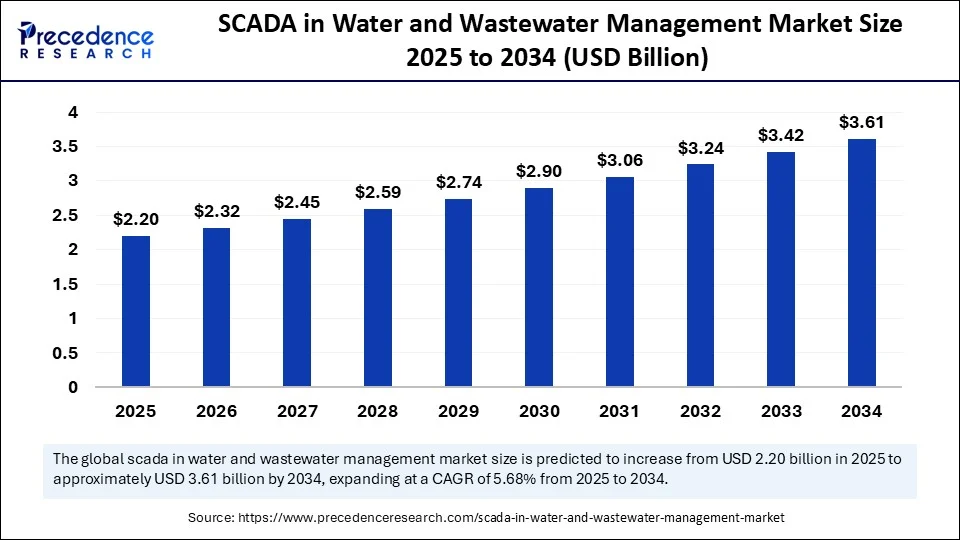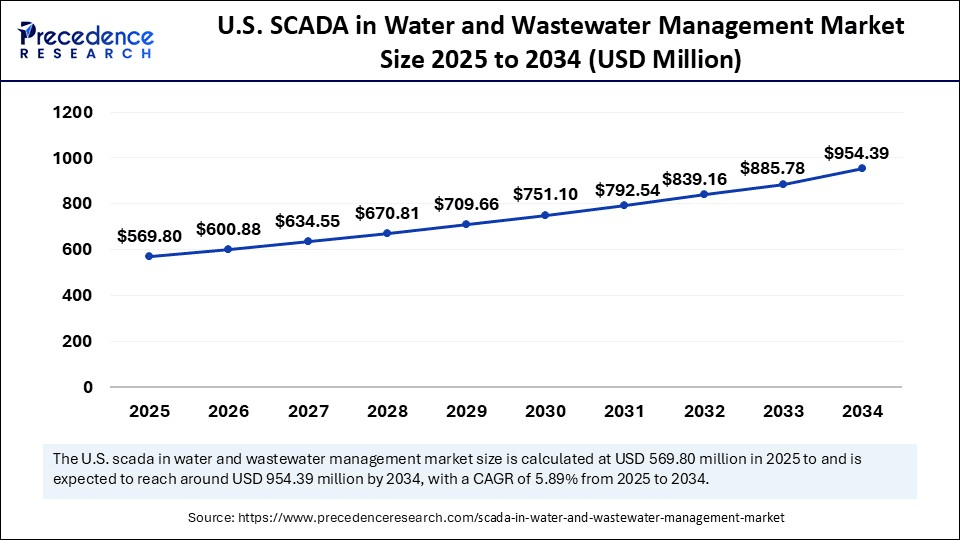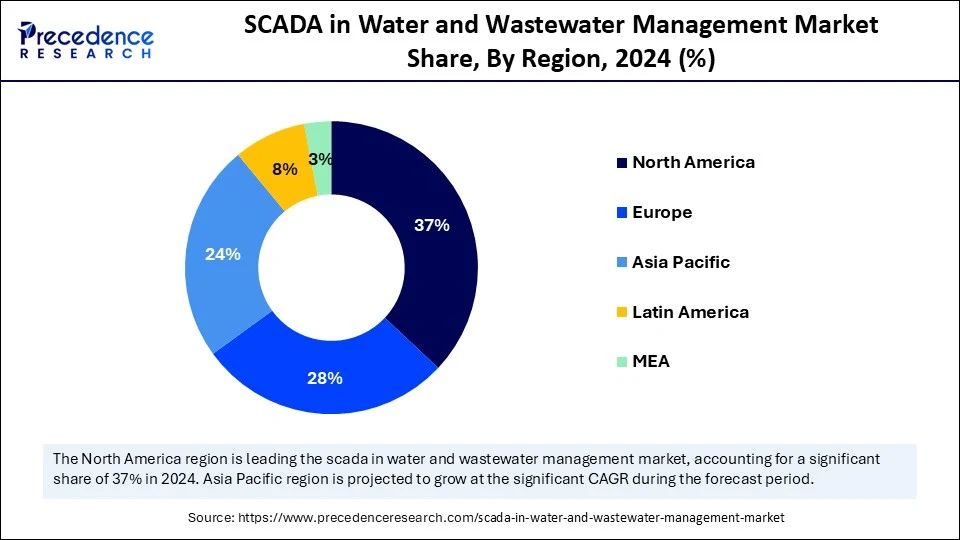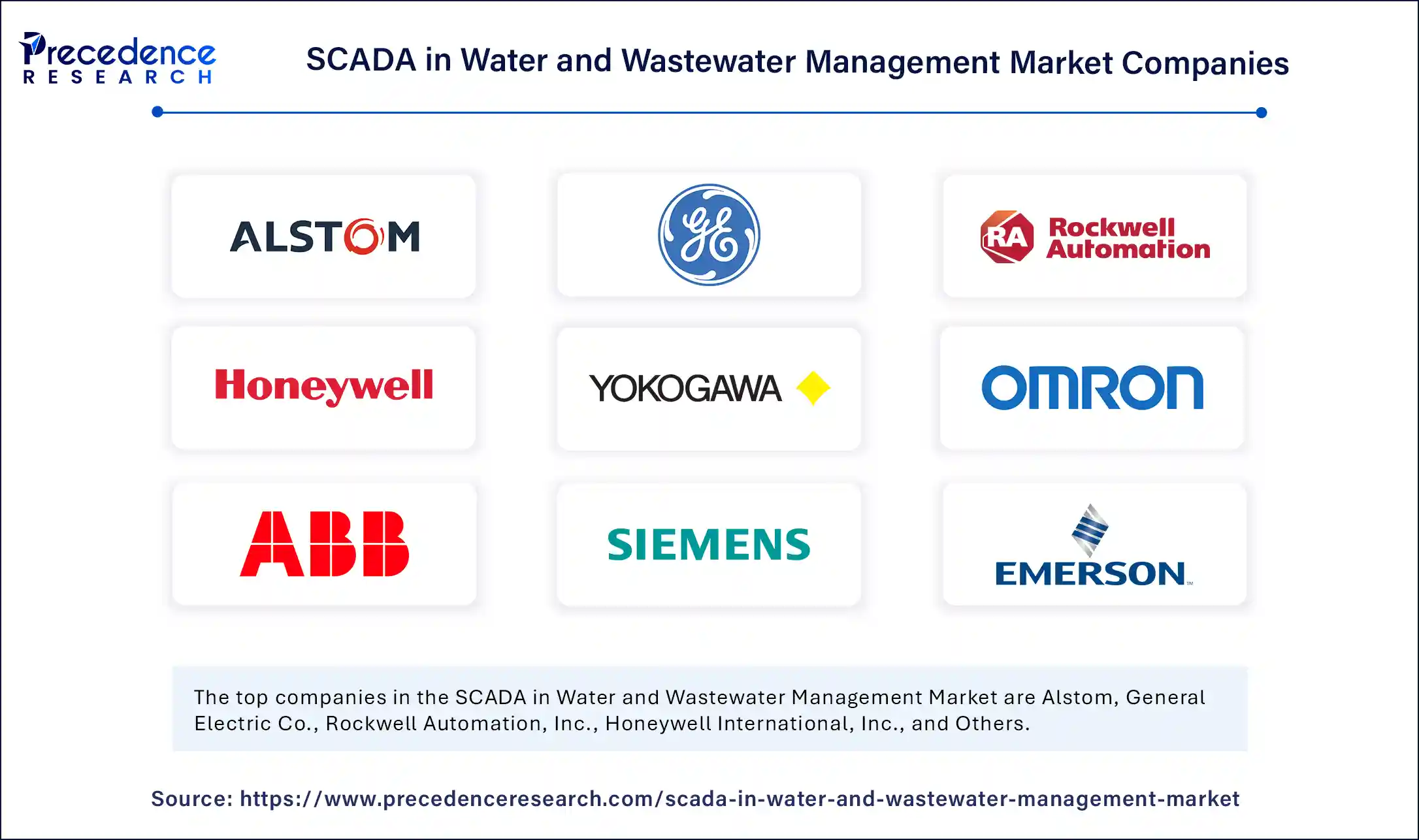List of Contents
SCADA in Water and Wastewater Management Market Size and Forecast 2025 to 2034
The global SCADA in water and wastewater management market size accounted for USD 2.08 billion in 2024 and is predicted to increase from USD 2.20 billion in 2025 to approximately USD 3.61 billion by 2034, expanding at a CAGR of 5.68% from 2025 to 2034. The market is expanding rapidly due to advances in real-time monitoring and control technologies and the rising demand for efficient water and wastewater management solutions, driven by urbanization and environmental concerns.

SCADA in Water and Wastewater Management Market Key Takeaways
- In terms of revenue, the global SCADA in water and wastewater management market was valued at USD 2.08 billion in 2024.
- It is projected to reach USD 3.61 billion by 2034.
- The market is expected to grow at a CAGR of 5.68% from 2025 to 2034.
- North America dominated the global SCADA in water and wastewater management market with the largest share of 37% in 2024.
- Europe is expected to grow at the fastest CAGR from 2025 to 2034.
- By function, the human machine interface segment held the biggest market share in 2024.
- By function, the programmable logic controller segment is expanding at a significant CAGR from 2025 to 2034.
- By component, the software segment contributed the highest market share in 2024.
- By component, the hardware segment is expanding at a significant CAGR during the forecast period.
- By end-user, the residential segment held the major market share in 2024.
- By end-user, the industrial segment is projected to grow at a CAGR between 2025 and 2034.
How Does AI Transform the SCADA in Water and Wastewater Management Market?
Artificial intelligence (AI) is revolutionizing the SCADA in water and wastewater management market by analyzing real-time sensor data to enable predictive maintenance, optimize treatment processes, and enhance water quality monitoring. AI can also improve treatment efficiency by automating processes such as aeration, chemical dosing, and sludge management, reducing resource consumption. It can detect subtle anomalies in water quality parameters, adjusting treatment accordingly to ensure safe, clean water. These capabilities lead to greater efficiency, lower costs, and more sustainable water resource management. Overall, AI significantly revolutionizes SCADA systems by enhancing operational efficiency and predictive maintenance.
U.S. SCADA in Water and Wastewater Management Market Size and Growth 2025 to 2034
The U.S. SCADA in water and wastewater management market size was exhibited at USD 538.72 million in 2024 and is projected to be worth around USD 954.39 million by 2034, growing at a CAGR of 5.89% from 2025 to 2034.

What Factors Contributed to North America's Dominance in the SCADA in Water and Wastewater Management Market in 2024?
North America dominated the SCADA in water and wastewater management market by capturing the largest revenue share in 2024. This is mainly due to its robust infrastructure, technological progress, and proactive government initiatives in wastewater treatment, fueled by population growth and industrial development. As the region's water and wastewater infrastructure ages, upgrades and modernization become essential. SCADA systems play a crucial role in optimizing these systems and ensuring their efficient operation. Additionally, North America is a hub for technological innovation, with companies like Emerson Electric Co., Honeywell International Inc., and Rockwell Automation, Inc. advancing and adopting sophisticated solutions like cloud computing for real-time water and wastewater management. The rising need for efficient wastewater management solutions ensures the long-term growth of the market.
In April 2024, Veolia North America and the Sewerage and Water Board of New Orleans (SWBNO) formed a partnership to collect, treat, and manage wastewater, transforming the byproducts of wastewater treatment into environmental assets and improving residents' quality of life. This collaboration is enhancing water quality and operational efficiency and providing critical support during hurricanes and natural disasters.
(Source: https://www.veolianorthamerica.com)
U.S. SCADA in Water and Wastewater Management Market Trends
The U.S. holds a dominant position in the market. There is a high demand for real-time monitoring, control, and data collection for various processes, including water and wastewater treatment, distribution, and collection. SCADA allows for remote oversight of facilities, especially valuable for geographically dispersed systems. This reduces operational costs, increases responsiveness during emergencies, improves efficiency, minimizes downtime, and enhances overall water quality.

How is Europe Emerging as the Fastest-Growing Region?
Europe is expected to grow at the fastest CAGR during the projection period. The growth of the market within the region stems from rising demand for automation, stringent environmental regulations, and increasing government investments aimed at modernizing infrastructure. Increased urbanization and population density are straining water resources, requiring advanced control systems. Further investments in water infrastructure, along with government support, are accelerating SCADA system adoption to enable more efficient and proactive water resource management.
In April 2025, the launch of the SCADA system in Ungheni marked a major step toward improving the efficiency and quality of services for residents, aligning with Ungheni's goal to become a smart city. Vitalie Vrabie, the Mayor of Ungheni, expressed gratitude to the European Union and the EU4 Moldova: Focal Regions Program for their invaluable support.
(Source: https://www.undp.org)
Germany SCADA in Water and Wastewater Management Market Trends
Germany plays a crucial role in the market. Known for its strong focus on environmental protection and sustainability, Germany finds SCADA systems particularly relevant for managing water and wastewater. The country's commitment to innovation and technology also promotes SCADA adoption across industries. Furthermore, Germany's decentralized water management approach, involving many municipalities and regional operators, relies heavily on SCADA for efficient coordination and control.
Why is the Asia Pacific Considered a Notable Region?
Asia Pacific is considered to be a notably growing region. The growth of the SCADA in water and wastewater management market within Asia Pacific is driven by rapid urbanization, industrialization, and population growth. There is a high demand for robust water and wastewater management systems in the industrial sector. Governments of China, India, Japan, and South Korea are investing heavily in smart city developments, creating the need for smart SCADA systems. In addition, the growing scarcity of water and increasing wastewater treatment projects are likely to support regional market growth.
The National Hydrology Project of India leverages SCADA systems for real-time remote water resource monitoring and control, leading to better decision-making and automated gate operations.
(Source: https://nhp.mowr.gov.in)
In September 2023, the Rajasthan State Water Informatics Centre under the state Water Resources Department (WRD) expanded the scope of SCADA technology. WRD plans to soon equip the Indira Gandhi Canal with SCADA technology. Additionally, the Parvati Dam, the Som Kamla Amba Dam, and the Chapi Dam will be outfitted with this technology to provide real-time updates on water levels and availability, monitor inflow into dams, and control outflow through sluice gates.
(Source: https://timesofindia.indiatimes.com)
What Opportunities Exist in the Latin America SCADA in Water and Wastewater Management Market?
The market within Latin America is expected to grow at a steady rate due to its abundant water resources and the ongoing challenge of water access and treatment. The reliance of the region on hydropower for electricity emphasizes the importance of effective water management. Initiatives like the Latin American Clean Water Initiative and investments in wastewater infrastructure highlight a growing focus on improving water management through SCADA and related technologies.
Middle East and Africa SCADA in Water and Wastewater Management Market Trends
The Middle East and Africa are witnessing notable growth in the market due to severe water scarcity, rapid urban growth, and significant infrastructure investments, especially in the oil and gas industries. This drives the demand for efficient water management systems, including SCADA. The high water consumption and strict environmental regulations in these industries require advanced monitoring and treatment solutions like SCADA. The widespread expansion of desalination plants further increases the need for SCADA systems to manage and optimize these facilities.
Market Overview
The SCADA in water and wastewater management market is experiencing significant growth due to increasing automation demands, strict environmental regulations, and the need for efficient resource management. SCADA (Supervisory Control and Data Acquisition) systems are digital networks and computer systems that collect, analyze, and transmit real-time data from various points in a water or wastewater treatment process using sensors and devices. This enables remote operation with improved efficiency and better decision-making. The market includes the design, development, implementation, and maintenance of SCADA systems specifically for water and wastewater management. These systems are used across treatment plants, pumping stations, distribution networks, and collection systems, helping ensure water quality, reduce losses, and promote sustainability.
What are the Key Trends in the SCADA in Water and Wastewater Management Market?
- Demand for Sustainable Solutions: SCADA systems help to optimize water and energy consumption, reduce operational costs, minimize environmental impact, aligning with sustainability goals and regulatory requirements in water and wastewater management.
- Increasing Demand for Treated Water: Growing populations and industrial development are driving the need for reliable and efficient water and wastewater treatment, leading to increased adoption of SCADA systems.
- Increased Cybersecurity Concerns: Growing awareness of cybersecurity threats to critical infrastructure is driving the demand for secure communication protocols and robust security features in SCADA systems, leading to increased investment in secure systems, especially in the water and wastewater sector.
- Technological Advancements: Continuous advancements and innovations in SCADA technology, including AI integration and cloud-based solutions, are enhancing the capabilities and efficiency of these systems in managing large-scale water and wastewater systems.
Market Scope
| Report Coverage | Details |
| Market Size by 2034 | USD 3.61 Billion |
| Market Size in 2025 | USD 2.20 Billion |
| Market Size in 2024 | USD 2.08 Billion |
| Market Growth Rate from 2025 to 2034 | CAGR of 5.68% |
| Dominating Region | North America |
| Fastest Growing Region | Asia Pacific |
| Base Year | 2024 |
| Forecast Period | 2025 to 2034 |
| Segments Covered | Function, Component, End User and Region |
| Regions Covered | North America, Europe, Asia-Pacific, Latin America, and Middle East & Africa |
Market Dynamics
Drivers
Increasing Demand for Automation and Remote Monitoring
The primary driver of the SCADA in water and wastewater management market is the increasing demand for automation and remote monitoring to improve operational efficiency, resource management, and regulatory compliance. This is further supported by efforts to optimize water treatment and distribution processes, manage pumping stations, detect leaks, and ensure water quality through remote monitoring. These capabilities enable operators to oversee systems from a central or remote location. As a result, these systems help reduce energy consumption, minimize water loss via leaks, and enhance overall operational efficiency, ultimately leading to cost savings.
Restraint
High Initial Cost of Implementation and Ongoing Maintenance
A major factor restraining the growth of the SCADA in water and wastewater management market is the high initial cost of implementation and ongoing maintenance of SCADA systems. This challenge is compounded by the significant upfront capital required for sensors, controllers, communication equipment, and SCADA software. Integrating these systems with legacy infrastructure, often not designed for digital technologies, can further increase costs. Additionally, proper training for personnel to operate and maintain these systems raises overall expenses.
Opportunity
Integration of Advanced Technologies
A key opportunity for the growth of the SCADA in water and wastewater management market lies in the integration of advanced technologies such as internet of things (IoT), AI, andmachine learning to create smarter, more efficient, and resilient systems. This development is driven by increased connectivity and the need for robust cyber security to protect these systems from threats. These innovations also facilitate remote monitoring, predictive maintenance, and improveddata analytics to support better decision-making, resource optimization, and asset management. Moreover, the rising demand for smart water management solutions creates immense opportunities in the market.
Function Insights
Why Did the Human Machine Interface Segment Dominate the SCADA in Water and Wastewater Management Market in 2024?
The human machine interface segment dominated the market with the biggest revenue share in 2024. This is mainly due to the increased need for real-time monitoring and remote access to improve operational efficiency and decision-making in water and wastewater management. HMI bridges the link between operators and complex SCADA systems, providing a user-friendly interface for monitoring and controlling processes within water and wastewater treatment facilities. Such systems allow operators to anticipate potential issues and schedule maintenance proactively, reducing downtime and preventing costly failures. They can be programmed to trigger alerts based on predefined thresholds, enhancing overall process efficiency.
In November 2024, Advantech launched HMINavi, an innovative open-source HMI software designed to transform industrial control and visualization. HMINavi is scalable and versatile, compatible with any x86 Windows system, and supports both offline and online simulation modes to streamline HMI design and testing.
(Source: https://www.advantech.com)
The programmable logic controller segment is expected to grow at the fastest rate during the forecast period, driven by its ability to automate key processes in water and wastewater treatment plants, control pumps and valves, and monitor water quality to improve efficiency and system performance. Automation reduces manual intervention, human error, and operational costs. Their flexibility, scalability, and ease of programming make PLCs ideal for managing complex treatment processes.
Component Insights
What Made Software the Dominant Segment in the Market?
The software segment dominated the SCADA in water and wastewater management market with the largest share in 2024, mainly because it provides actionable insights from real-time data. The increased need for automated, data-driven decision-making further supported this segment's dominance. Software enables remote monitoring and control, allowing operators to modify parameters, optimize processes, and address issues from any location. Integrating AI and machine learning further enhances software capabilities by analyzing historic and current data to predict problems like equipment failures or water quality fluctuations by permitting proactive maintenance and better resource allocation.
In June 2024, AVEVA announced updates to its InTouch Unlimited HMI/SCADA software, including new features, improved commercial models, and pricing options to help end users, equipment manufacturers, and system integrators develop and scale HMI/SCADA applications from the edge to the cloud, with added analytics.
(Source: https://www.aveva.com)
The hardware segment is expected to grow the fastest CAGR in the upcoming period due to its essential role in data collection and real-time process monitoring. Hardware components like sensors, controllers, and communication devices enable efficient, reliable operation by providing critical parameter data such as water quality, flow rates, and pressure. This segment's growth is spurred by increasing investments in infrastructure upgrades by municipalities and industries that require dependable and advanced hardware.
End-user Insights
How Does the Residential Segment Dominate the Market in 2024?
The residential segment dominated the SCADA in water and wastewater management in 2024. This is mainly due to the large number of residential water users and the increased need for a consistent water supply in households. Investments in automation and control systems aimed at improving efficiency and conserving energy are increasing. The integration of SCADA with IoT technologies is also encouraging the adoption of home automation solutions, further expanding this segment. Ensuring reliable and efficient water management is crucial for public health and safety, encouraging investments in SCADA systems for residential water and wastewater management.
The industrial segment is expected to expand at the fastest rate during the projection period due to the increasing demand for automation, real-time data monitoring, and improved operational efficiency in industrial processes. Nowadays, industries are increasingly adopting SCADA systems to automate complex processes, reduce manual intervention, and enable remote monitoring of operations, resulting in improved efficiency and reduced operational costs. This growth is further fueled by the demand for enhanced security, integration with emerging technologies like IoT and cloud computing, and the development of user-friendly interfaces.
SCADA in Water and Wastewater Management Market Comapanies

- Alstom
- General Electric Co.
- Rockwell Automation, Inc.
- Honeywell International, Inc.
- Yokogawa Electric Corporation
- Omron Corporation
- ABB Ltd.
- Siemens AG
- Emerson Electric Co.
- Schneider Electric SE
Recent Developments
- In February 2025, the Lucknow Municipal Corporation announced a plan to implement an advanced SCADA system under the AMRUT mission, enabling real-time monitoring and automated adjustments to optimize water distribution and prevent shortages by collecting data from remote sensors and actuators. Municipal Commissioner Inderjit Singh highlighted the importance of centralized supervision.
(Source: https://timesofindia.indiatimes.com) - In December 2024, TAQA Water Solutions awarded a AED95 million project to develop a SCADA system across its treatment infrastructure, centered around a new, centralized control facility announced during the IDRA World Congress 2024. This project aims to boost environmental sustainability, enhance operational efficiency, and increase wastewater treatment capacity by approximately 20 percent.
(Source: https://www.taqa-ws.com)
Segments Covered in the Report
By Function
- Human Machine Interface
- Remote Terminal Unit
- Programmable Logic Controller
- Communication System
- Others
By Component
- Software
- Hardware
By End-User
- Residential
- Industrial
By Region
- North America
- Europe
- Asia-Pacific
- Latin America
- Middle East and Africa
For inquiries regarding discounts, bulk purchases, or customization requests, please contact us at sales@precedenceresearch.com
Frequently Asked Questions
Ask For Sample
No cookie-cutter, only authentic analysis – take the 1st step to become a Precedence Research client